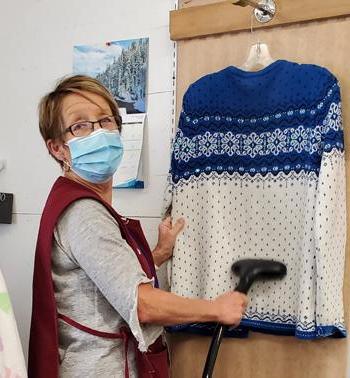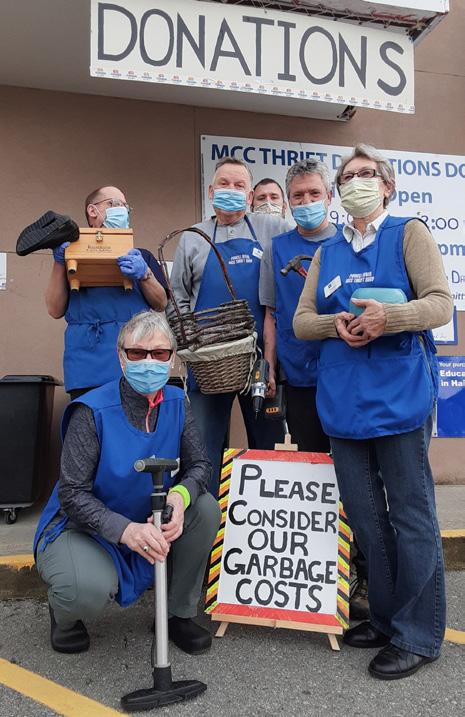
5 minute read
Our super-green thrifting scene
Hundreds of volunteers • Thousands of garments Hundreds of thousands of dollars in donations to charities
Advertisement
In April, we celebrate both Earth Day and Volunteer Month. It’s a perfect time to showcase Qathet’s environmental heroes: the volunteers receiving, sorting, repairing, and selling clothes and more at our downtown thrift stores. qathet’s thrifting scene–at stores, online, and at yard sales–is perhaps our most significant collective re-use project. On its own, thrifting won’t solve climate change. But the values behind the thrifting movement are the keys to our survival. Our super-green thrifting scene
Health Care Auxiliary
Carol Skorey, Membership Chair and Advertising Chair
How many volunteers do you have?
Carol • We currently have 254 members, some are not returning since COVID-19 but we are also getting some new members.
About how many volunteer hours go into your work each month?
Carol • In 2018-2019 we had 58,329 volunteer hours but in 2020 due to being closed so much we dropped to 35,139! Things are really picking up now, though, so it will be interesting to see how it goes.

Harry Bey sorts electronics
How much clothing gets donated to your store?
Carol • Powell River is very generous with clothing donations, what we can’t sell goes to a company called Cann Amm and we receive a cheque from them according to weight. In 2020 we kept 95,076 pounds out of landfill .

Wendy Price and Leah Kulcheski are running the jewellery counter
How much gets tossed as garbage?
Carol • Very little goes into the garbage as we recycle almost all of these items: clothing, purses, shoes, belts, hats and linens. Jewellery is remade into saleable pieces.
Apart from recycling, what good does your store do?
Carol • Our Economy shop donates every penny earned after expenses and it stays in Powell River and goes to health-related areas such as the Hospital, Evergreen ECU and Willingdon Creek, also Danielle’s Helping Hands Fund, Therapeutic Riding, Paddling for Life, Mental Health Daycare Unit, free TV and earbuds for the patients, Youth Volunteers Programme, and Texada Island Health Unit. We supply oncology bags and supplies, COVID relief food hampers to Tla’amin Nation, and much more. The list is long and does change from year to year depending on need. The bulk of the money goes to the Hospital ECU and Willingdon Creek. In 2020, even with all the closures and reduced hours, we were able to donate $273,975.75 to these various areas!

Vicki McClennon is sorting clothes.
Anything else you’d like to add?
Carol • One big problem we have is that there is nowhere to recycle books or magazines here anymore. We are hoping that our community or province comes up with a solution to keep these items out of the landfill.
MCC Thrift Store
Mary McKenzie, store manager
Apart from recycling, what good does your store do?
Mary • We have approximately 70 volunteers on rotation. How many volunteer hours a month? Mary • Together they do approximately 800+ hours per month. Some months more, if there are events.

PUMPED FOR YOUR DONATIONS: MCC volunteers Angelique Veerman, Peter Laframboise, Lee Guay, Dietmar Peters and Erika Rapp, along with staffer Richard Lang, are just a few of the 70-person team that sort thousands of kilograms of donations each week. How many volunteers do you have?
How did the pandemic change what you do?
Mary • We lost 20 volunteers to the pandemic; probably half will be permanent. The pandemic brought a higher in-flux of donations, due to everyone home and wanting to downsize and minimalize! It also affected us in that we were closed for two months and are still not fully operational. We are open only five days a week, six hours a day. Originally we were six days, eight hours a day.
How much gets tossed as garbage?
Mary • Approximately 75-100 kilograms, twice a week. This works out to 9,600 kg per year. This is after we do metal, plastic, electronic, book and clothing recycling. Most of our donations are saleable, yet we are often left with unsaleable items. These are represented by unwashed clothing, incomplete and broken appliances, toys and housewares – many items long past their “expiry date.”
Apart from recycling, what good does your store do?
Mary • 10 percent of net is donated to LIFT. We support clients from STRIVE and inclusion Powell River with opportunities for weekly volunteer hours which then provides them with a government stipend. We do a work experience program with Brooks School, offering weekly opportunities to gain experience in a structured environment so students can gain confidence in applying for jobs. We have a bike program, where community bikes are re- purposed, reused, and renewed.
Volunteers make shopping bags out of unsaleable t-shirts. We supply hundreds of coats, hats, scarves and gloves for the Coldest Night of the Year campaign.
For Powell River Search and Rescue, we supply sleeping bags, blankets, etc for their rescues.
We have supported two Syrian families in the last two years with full provisions to set up their homes through Hands Across the Waters.
Many believe all MCC does is send monies overseas. We are a peace, development and emergency relief organization. But we also support local communities. We are always willing to supply furniture, household items and clothing to help locals get a step up as they move out of homelessness.
We have local schools that need help with school supplies, books and games. We are always a willing YES to anyone who needs help.
Salvation Army Thrift Store
Major Rosanne Fraser
How many volunteers do you have?
'Rosanne • We have 12 volunteers, and together they work about 300 hours a month

How did the pandemic change what you do?
Rosanne • At first the whole store was closed, so we had no volunteers working. When we reopened, we only allowed 15 shoppers at a time, and we brought the volunteers back in slowly. Plus we added the usual measures: hand sanitizer, etc.
How much gets tossed as garbage?
Rosanne • We get about 10 large garbage bags a day, so about 30 a week over the three days we’re open for donations. The quality of the donations really determines the amount of garbage we throw out, but it’s usually about 1,600 pounds of clothes every month. Apart from recycling, what good does your store do? Rosanne • All Salvation Army donations stay local. All money is used for helping local poeple in need. We also provide vouchers for clothing, bedding and household items. We issue them at the church and the recipient can use the voucher in our store. We have donated items to families who have lost their belongings due to fire. Before COVID, people were able to come in and relax in the upper area of the store, and purchase a coffee or a cold drink. We appreciate the hours and hard work our volunteers put in to our store each week. They are a great asset to our team.




